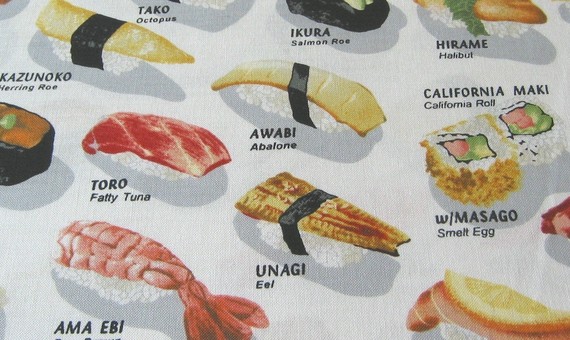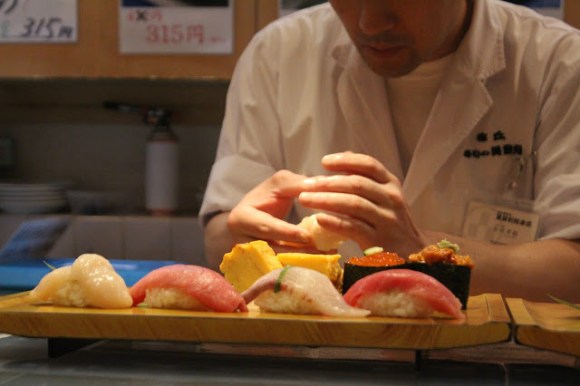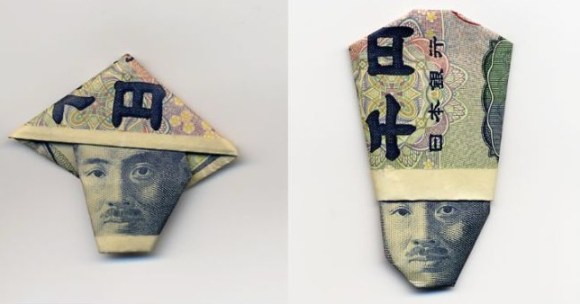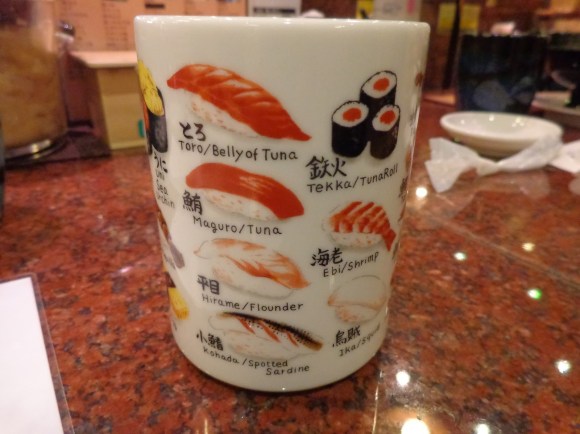
Japan’s sushi restaurants range from some of the finest cuisine in the world, to cheerful conveyer-belt gigs where everything is 100 yen (oh, alright then, 108 yen) and comes with a free toy. For those of us accustomed to the “sushi-go-round” that is kaiten-zushi, visiting a “proper” sushi restaurant in Japan where there’s no rotating belt of plates to choose from can be a daunting experience.
When there’s no menu, and you’re alone at the counter, quivering under the watchful eye of an intimidating chef armed with giant swishy blades, how do you order with confidence? Who better to ask than a sushi itamae, a high-end chef of Japanese cuisine. One of our intrepid Japanese reporters went to ask one of these top sushi chaps, who gave us his best three tips for sounding like you know what you’re doing at the counter.
▼ “Gimme something giant!!!” is probably not the right way to begin.
#3 – Name your price
When you visit a sushi restaurant in Japan, you can choose a set-priced o-makase (the chef’s choice; o-makase literally means “leave it up to you”). But you can also tell the chef how much you want to spend, instead. “Many people order the ‘special’ or ‘extra special’ o-makase, but when I hear someone name their own price instead and say ‘I’ll leave it up to you’, I know they know what they’re doing”, our expert says.
Telling the chef what your price-range is doesn’t necessarily mean you’re spending a lot – but it allows him to serve up as many delicious plates as you can afford. And in asking that of the chef, you’re also recognising and honouring his talent and experience. That’s what we call a win-win situation!
▼ It’s not about the money, money, money… (except for when it is).
#2 – Gimme what’s good today!
Similar to the o-makase, asking the chef to serve what’s fresh today is a sure-fire sign of a customer who knows their stuff. “When I hear that, I know I can’t serve them anything that’s a bit lacking”, explains our man. “It makes me nervous! But it also actually makes my job a bit easier, as I can just serve up what I think the best thing we have today is.”
▼ It’s pretty unlikely that you’ll get your green tea in a cup like this, but we reckon it’d be useful when ordering.
And finally, the number one tip, which as you might hope for from an expert in his field, is something of a wild card:
#1 – First off, order the cheapest nigiri on the menu
“When a first-time customer comes in alone and orders the nami nigiri [the cheapest chef’s selection of ordinary sushi], I’m 100 percent certain they know what they’re doing.” It might sound backwards, but ordering the nami (並 “ordinary”) instead of the more expensive jou (上, “special”) or tokujo (特上 “super-awesome special”), can actually work to single you out as a sushi pro. “If it’s good,” he explains, “you can keep ordering and try something more expensive, and if it’s no good, you can get the bill and go someplace else. That’s what people doing the rounds of different sushi restaurants do.”
Well there we have it! We’ve always felt a bit like a dirty skinflint ordering the nami every time, but it turns out we were signalling ourselves to be sushi experts! Now we can order sushi like a boss – which is to say, in unintimidated contentment.
Top image: luckykaerufabric/etsy
[ Read in Japanese ]




 Does how you dress affect what a sushi restaurant serves you? We experiment in Ginza
Does how you dress affect what a sushi restaurant serves you? We experiment in Ginza How to eat sushi like a sensei 【Video】
How to eat sushi like a sensei 【Video】 This sushi restaurant’s take-home temakizushi set is insanely satisfying for a great price
This sushi restaurant’s take-home temakizushi set is insanely satisfying for a great price What should you use table salt for at a sushi restaurant? We asked a kaitenzushi maniac
What should you use table salt for at a sushi restaurant? We asked a kaitenzushi maniac We search for the best sushi in Kenya
We search for the best sushi in Kenya 7-Eleven Japan’s ramen-cooking robot whipped us up a bowl of noodles【Taste test】
7-Eleven Japan’s ramen-cooking robot whipped us up a bowl of noodles【Taste test】 Lacquerware supplier to emperor of Japan and Pokémon team up for new tableware
Lacquerware supplier to emperor of Japan and Pokémon team up for new tableware Is it rude to sing along at concerts in Japan? We ask a pro musician for his take
Is it rude to sing along at concerts in Japan? We ask a pro musician for his take Can a dirty butthole make you filthy rich in Japan? We’re starting a New Year’s lottery experiment
Can a dirty butthole make you filthy rich in Japan? We’re starting a New Year’s lottery experiment 7-Eleven Japan starts new temporary luggage storage service in over 300 branches
7-Eleven Japan starts new temporary luggage storage service in over 300 branches New retro museum in Tokyo is like a time portal back to the Showa era【Photos】
New retro museum in Tokyo is like a time portal back to the Showa era【Photos】 Rental grandma service growing in Japan, can help cook or break up with boyfriends
Rental grandma service growing in Japan, can help cook or break up with boyfriends Starbucks Japan reveals this year’s lucky bag bundle, pre-order lottery opens tomorrow
Starbucks Japan reveals this year’s lucky bag bundle, pre-order lottery opens tomorrow Put your kitsune up! BABYMETAL is set to dominate the world with ‘dangerous kawaii’【Interview】
Put your kitsune up! BABYMETAL is set to dominate the world with ‘dangerous kawaii’【Interview】 We attempt to solve the Millennium Puzzle from Yu-Gi-Oh! ourselves, gain new respect for Yugi
We attempt to solve the Millennium Puzzle from Yu-Gi-Oh! ourselves, gain new respect for Yugi Disillusionment at Tsukiji’s tourist-target prices led us to a great ramen restaurant in Tokyo
Disillusionment at Tsukiji’s tourist-target prices led us to a great ramen restaurant in Tokyo Starbucks teams up with 166-year-old Kyoto doll maker for Year of the Horse decorations【Photos】
Starbucks teams up with 166-year-old Kyoto doll maker for Year of the Horse decorations【Photos】 Japan may add Japanese language proficiency, lifestyle classes to permanent foreign resident requirements
Japan may add Japanese language proficiency, lifestyle classes to permanent foreign resident requirements Starbucks Japan releases new zodiac chilled cup drink for 2026
Starbucks Japan releases new zodiac chilled cup drink for 2026 Tokyo’s Tsukiji sushi neighborhood asks tour groups to stay away for the rest of the month
Tokyo’s Tsukiji sushi neighborhood asks tour groups to stay away for the rest of the month Is this the most relaxing Starbucks in Japan?
Is this the most relaxing Starbucks in Japan? Starbucks on a Shinkansen bullet train platform: 6 tips for using the automated store in Japan
Starbucks on a Shinkansen bullet train platform: 6 tips for using the automated store in Japan Street Fighter Hadouken Churros to be launched and eaten in Tokyo, Okami pudding on offer too
Street Fighter Hadouken Churros to be launched and eaten in Tokyo, Okami pudding on offer too Japan’s human washing machines will go on sale to general public, demos to be held in Tokyo
Japan’s human washing machines will go on sale to general public, demos to be held in Tokyo Japanese train company is letting fans buy its actual ticket gates for their homes
Japanese train company is letting fans buy its actual ticket gates for their homes Tokyo considering law requiring more trash cans following litter increase in heavily touristed area
Tokyo considering law requiring more trash cans following litter increase in heavily touristed area Nintendo’s Kirby now delivering orders at Kura Sushi restaurants, but not in Japan
Nintendo’s Kirby now delivering orders at Kura Sushi restaurants, but not in Japan Tokyo event lets you travel back in time, for free, to celebrate 100 years since Showa era start
Tokyo event lets you travel back in time, for free, to celebrate 100 years since Showa era start Sanrio theme park in Japan announces plans to expand into a Sanrio resort
Sanrio theme park in Japan announces plans to expand into a Sanrio resort Survey asks foreign tourists what bothered them in Japan, more than half gave same answer
Survey asks foreign tourists what bothered them in Japan, more than half gave same answer Japan’s deadliest food claims more victims, but why do people keep eating it for New Year’s?
Japan’s deadliest food claims more victims, but why do people keep eating it for New Year’s? We deeply regret going into this tunnel on our walk in the mountains of Japan
We deeply regret going into this tunnel on our walk in the mountains of Japan Studio Ghibli releases Kodama forest spirits from Princess Mononoke to light up your home
Studio Ghibli releases Kodama forest spirits from Princess Mononoke to light up your home Major Japanese hotel chain says reservations via overseas booking sites may not be valid
Major Japanese hotel chain says reservations via overseas booking sites may not be valid Put sesame oil in your coffee? Japanese maker says it’s the best way to start your day【Taste test】
Put sesame oil in your coffee? Japanese maker says it’s the best way to start your day【Taste test】 The top 10 annoying foreign tourist behaviors on trains, as chosen by Japanese people【Survey】
The top 10 annoying foreign tourist behaviors on trains, as chosen by Japanese people【Survey】 No more using real katana for tourism activities, Japan’s National Police Agency says
No more using real katana for tourism activities, Japan’s National Police Agency says Starbucks Japan reveals new sakura drinkware collection, inspired by evening cherry blossoms
Starbucks Japan reveals new sakura drinkware collection, inspired by evening cherry blossoms New Ginza sushi bar offers 21-piece omakase course for just US$60
New Ginza sushi bar offers 21-piece omakase course for just US$60 Japanese sushi hack: how to turn supermarket sushi into a restaurant-quality meal
Japanese sushi hack: how to turn supermarket sushi into a restaurant-quality meal This ISN’T what a US$100 Tokyo sushi lunch looks like. It’s what a US$200 one looks like!
This ISN’T what a US$100 Tokyo sushi lunch looks like. It’s what a US$200 one looks like! Kappa Sushi’s newest menu item is just sushi rice, but we’re not that mad about it, honestly
Kappa Sushi’s newest menu item is just sushi rice, but we’re not that mad about it, honestly What time of day gets you the best-tasting sushi at a revolving sushi restaurant?
What time of day gets you the best-tasting sushi at a revolving sushi restaurant? Master sushi chef effortlessly slices and dices vegetables while blindfolded【Video】
Master sushi chef effortlessly slices and dices vegetables while blindfolded【Video】 How to make one of the most complicated but awesome themed sushi rolls【Video】
How to make one of the most complicated but awesome themed sushi rolls【Video】 We visit “the best conveyor belt sushi restaurant in Japan”
We visit “the best conveyor belt sushi restaurant in Japan” Do you really know how to eat sushi? Probably not!
Do you really know how to eat sushi? Probably not! How well do you know your sushi? New 3-D puzzle toy from Japan helps you become a salmon pro
How well do you know your sushi? New 3-D puzzle toy from Japan helps you become a salmon pro This Tokyo sushi restaurant is so good that we’d eat there every day if we could
This Tokyo sushi restaurant is so good that we’d eat there every day if we could We investigate which conveyor belt sushi restaurant is best for drinking alone, drowning regrets
We investigate which conveyor belt sushi restaurant is best for drinking alone, drowning regrets We try Sexual Harassment Sushi, Soapland Sushi, and Ice Cream Sushi
We try Sexual Harassment Sushi, Soapland Sushi, and Ice Cream Sushi Customers’ Behaviour Changing Sushi Culture in Japan
Customers’ Behaviour Changing Sushi Culture in Japan Tokyo’s newest sushi restaurant is actually way too Japanese for its own good
Tokyo’s newest sushi restaurant is actually way too Japanese for its own good A report from the Kura Sushi sushi-making world championships【Photos】
A report from the Kura Sushi sushi-making world championships【Photos】
Leave a Reply